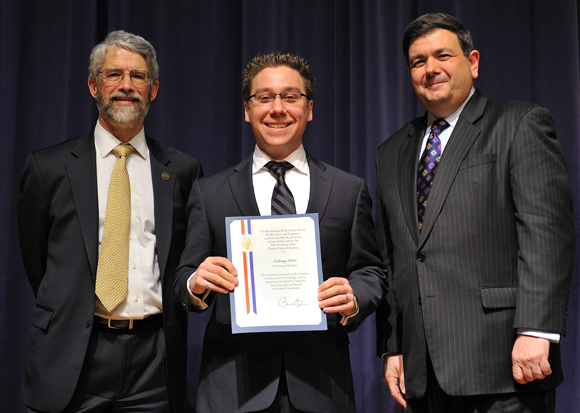Tony Grbic awarded Presidential Early Career Award
The PECASE is the highest honor bestowed by the U.S. government on outstanding scientists and engineers beginning their independent careers.

 Enlarge
Enlarge
Additional Information:
President Honors Outstanding Early-Career Scientists
Honoring Scientists and Engineers (January 14, 2010)
Original WhiteHouse Press Release (July 9, 2009)
The University Record
PECASE Funds Photonics Work (press release)
PECASE Award – DoD AFOSR
“It is a great honor to have been selected,” Grbic says. “The award will provide my research group with even greater research freedom and opportunities to pursue topics in the field of metamaterials. This research area is rather new and a lot of fundamental work remains.”

 Enlarge
Enlarge
President Barack Obama talks with the Presidential Early Career Award for Scientists and Engineers (PECASE) winners in the East Room of the White House, Jan. 13, 2010. January 13, 2010. (Official White House Photo by Lawrence Jackson)
Note: Look for Prof. Grbic in the second row, fourth from the left

 Enlarge
Enlarge
| Dr. John P. Holdren, Assistant to the President for Science and Technology & Director of the White House Office of Science and Technology Policy; Prof. Tony Grbic; Dr. Zachary J. Lemnios, Director, Defense Research and Engineering. |
Prof. Anthony (Tony) Grbic, assistant professor in the Radiation Laboratory, was awarded the highly prestigious Presidential Early Career Award for Scientists and Engineers (PECASE), announced July 9, 2009 by The White House. The PECASE is the highest honor bestowed by the U.S. government on outstanding scientists and engineers beginning their independent careers. Tony joined U-M in 2006 after receiving his M.A.Sc., M.A.Sc., and Ph.D. degrees in electrical engineering from the University of Toronto.
Prof. Grbic pursues both experimental and theoretical research in electromagnetics and microwave circuits. His research program involves both basic science (e.g. multidisciplinary work on metamaterials and near-field plates) as well as advanced technology development (e.g. antenna research and design, wireless component development).
He is a pioneer in the field of electromagnetic metamaterials, publishing highly influential papers even while working on his dissertation at the University of Toronto. His more recent work in this area is focused on the development of a special class of volumetric metamaterials which can overcome the bandwidth and loss limitations of current metamaterial designs. The superior performance of these metamaterials will allow them to be integrated into practical microwave focusing and antenna systems.

 Enlarge
Enlarge
He is now breaking ground in a new area that is of great interest among researchers, near-field superlenses, by pursuing an entirely new approach to manipulating and focusing the electromagnetic near field, which relies on modulated grating-like surfaces referred to as near-field plates (NFPs). NFP’s hold promise for a number of areas including high resolution probing devices, quasi-optical and optical components, devices for wireless non-radiative power transfer, as well as antennas and nano-antennas. In this work, he is actively collaborating with physics professor Roberto Merlin.
[Photo: Cyan James]
The article, �Near-Field Plates: Subdiffraction focusing with patterned surfaces,� by Anthony Grbic, graduate student Lei Jiang, and physics professor Roberto Merlin, appeared in Science, vol. 320, no. 5874, pp. 511-513, April 25, 2008. His research activities have also been been cited in Scientific American, Nature, Physics World, Physics Today, New Scientist, Discover Magazine and EE Times.
Prof. Grbic has received an AFOSR Young Investigator Award and an NSF Faculty Early Career Development Award. He is very active in professional societies, and is already a frequently invited speaker at professional conferences and symposiums. He teaches courses in introductory Electromagnetics, senior level Radiowave Propagation and Link Design, and graduate courses in Electromagnetic Metamaterials.
The PECASE Awards are intended to recognize some of the finest scientists and engineers who, while early in their research careers, show exceptional potential for leadership at the frontiers of scientific knowledge during the twenty-first century. The Awards foster innovative and far-reaching developments in science and technology, increase awareness of careers in science and engineering, give recognition to the scientific missions of participating agencies, enhance connections between fundamental research and national goals, and highlight the importance of science and technology for the nation’s future.
Several agencies participate in the PECASE awards. Prof. Grbic received his award from the Department of Defense, U.S. Air Force Office of Scientific Research.

 MENU
MENU 
